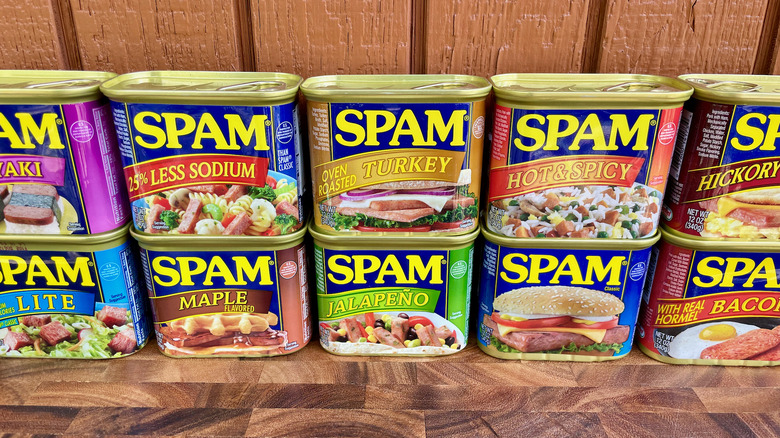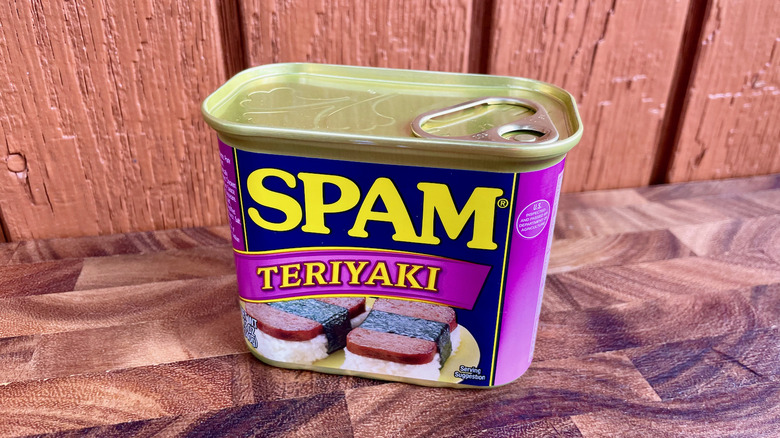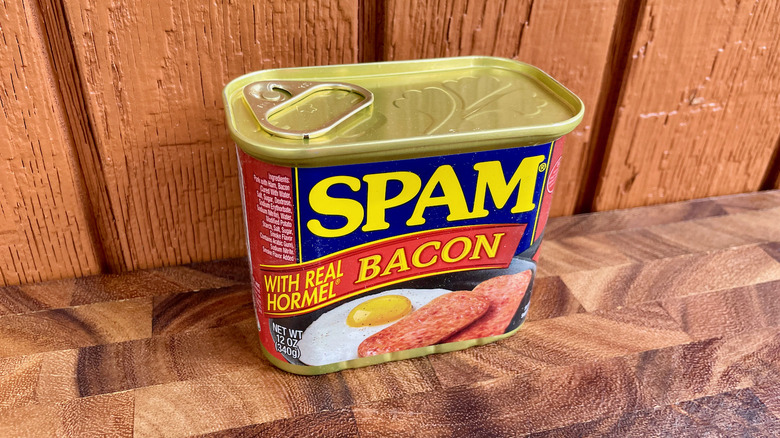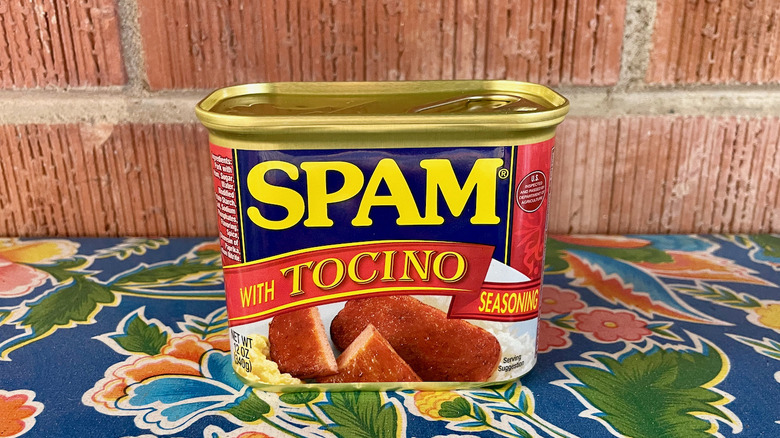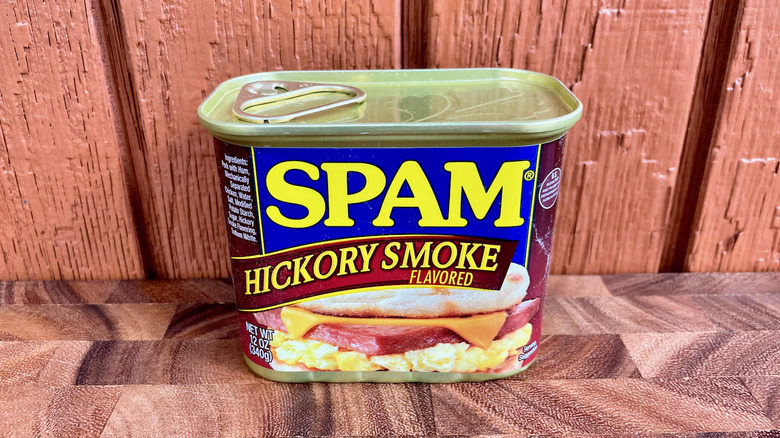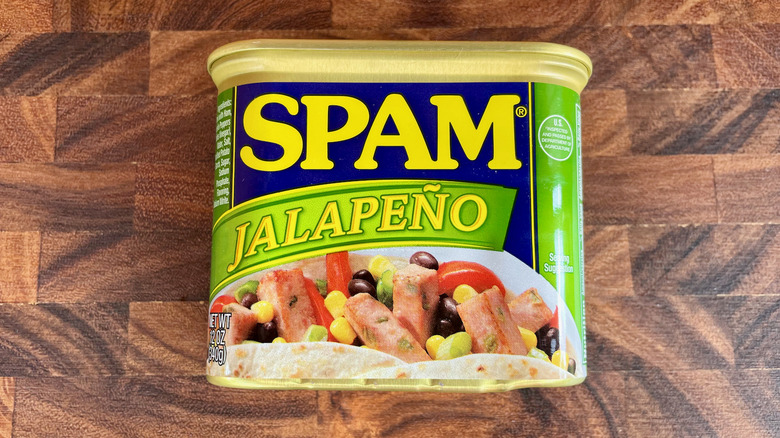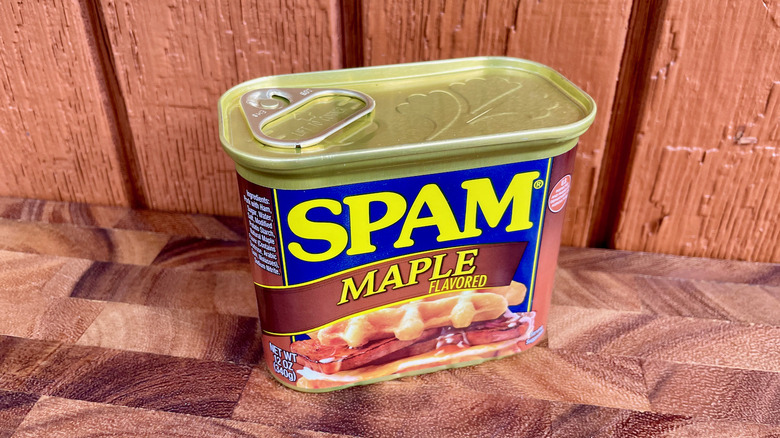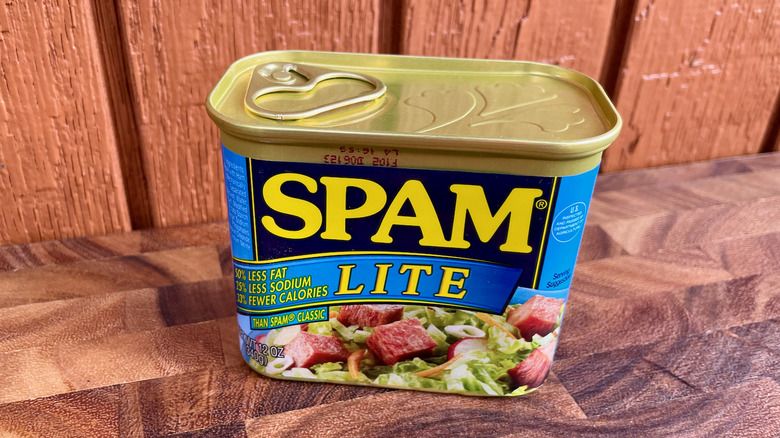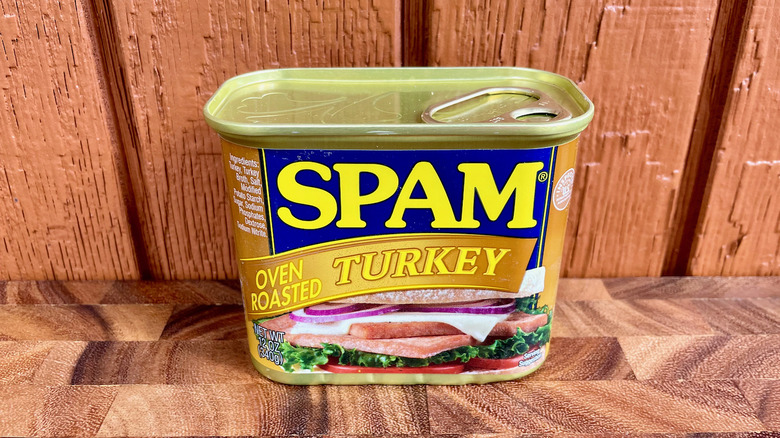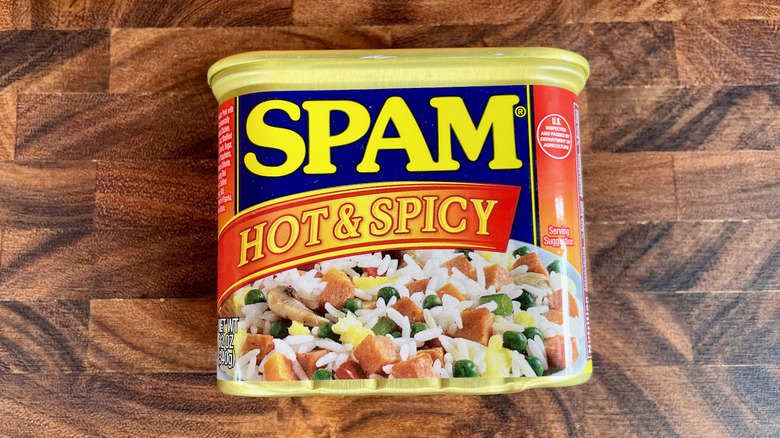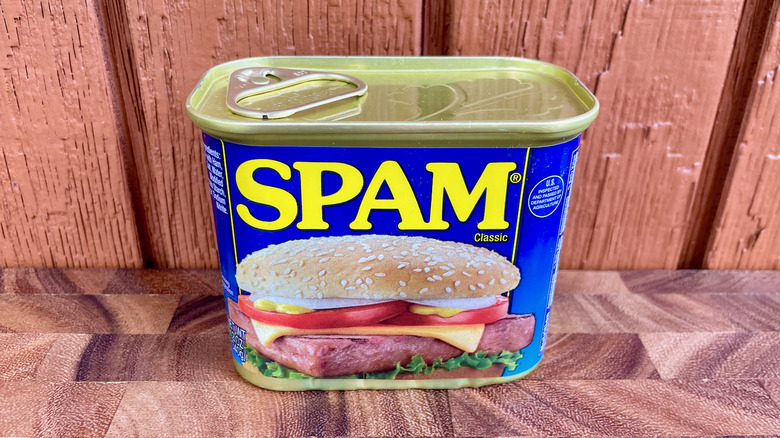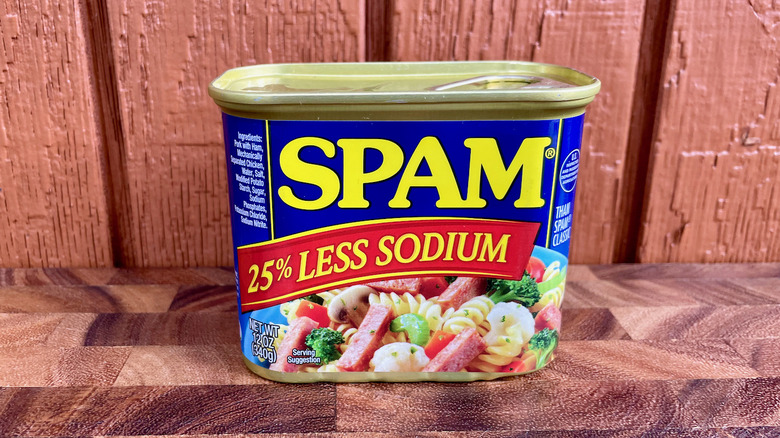Every Spam Flavor, Ranked Worst To Best
Spam is more than just the butt of a funny Monty Python joke. And it deserves greater respect than being written off as an emergency-preparedness ration that you'll only consume in dire circumstances. Although it gets a bad rap for being mystery meat, Spam Classic is made with only six ingredients: pork with ham, salt, water, starch, sugar, and sodium nitrite. And sure, it kind of looks like alien goo when it's sliding out of the iconic rectangular can, but once you slice it up and brown it, it's just as yummy as other types of cured meat like ham or bacon. Plus, it comes in a bunch of fun flavors.
That's right: what you might not know if you've been sleeping on Spam is that there are currently 11 varieties, including everything from spicy selections to sweet surprises to international spins on the classic formula. We're here to give the iconic canned meat its due by sampling every single flavor and telling you which ones are worth seeking out. Join us as we dive deep into the wonderful (and incredibly salty) world of Spam.
11. Teriyaki
We had high hopes for this one because normal Spam with teriyaki sauce is an excellent combination. The sweetness of the sauce complements the intense saltiness of the meat well, and teriyaki-glazed Spam is delicious when combined with rice and seaweed to make Spam musubi.
Sadly, this delivered little in the way of teriyaki flavor — it hardly even tasted like Spam. The meat had a strong poultry taste thanks to the inclusion of mechanically separated chicken, which is the second thing on the ingredients list. Many Spam varieties (though not the original one) have chicken mixed in with the pork, which we suspect is a cost-saving measure. It's not always a problem, but in this case, the poultry was a distraction from the savory pork. The meat was also super finely ground, which made it mushy, even after being crisped up in a skillet.
The two main components of teriyaki are sugar and soy sauce. Spam Teriyaki had a decent amount of sugar in it, but it didn't taste like soy sauce at all, despite containing soy sauce powder. It had a strange savoriness to it that was slightly reminiscent of soy, but reminded us more of Maggi seasoning or yeast extract. The result was slightly off-putting, which is why this Spam variety ranks dead last.
10. Bacon
If you're looking for a smoky-tasting can of Spam to start the day, we'd recommend the bacon flavor. Although no smoke or smoke flavoring was listed on the ingredients label, this Spam was made with ground-up bacon and rendered bacon fat, which brings a mild campfire presence. We also picked up a brown sugar-like flavor that we'd guess came from the bacon as well.
That sweetness was necessary because this Spam variety was a salt bomb. Despite the fact that Spam Bacon had significantly less sodium than classic original Spam, it tasted incredibly salty. The sugar helped counteract a bit of the sodium. Overall, this product really did have genuine bacon flavor, though it lacked the crispness we expect from the breakfast staple.
While we enjoyed Spam Bacon, we're not sure that it needs to exist. If you want a salty pork product that tastes like bacon in the morning, that product already exists: It's bacon. We're not sure why you'd choose the ground-up, canned version over the real thing unless you were stocking up your doomsday bunker.
9. Tocino
We wanted to like this flavor of Spam more than we did because it was so interesting. While most other Spam varieties feature recognizable American flavor profiles, U.S. diners might not be familiar with tocino, which is a type of Filipino cured meat. It comes in different permutations, with the most classic type made with fatty cuts of pork marinated in a heavy dose of salt, sugar, garlic, and red food coloring. Spam is incredibly popular in the Philippines, so it makes sense that Hormel would shout out its Filipino customers by making a version of the canned meat that's inspired by another of the nation's favorite pork products.
Spam Tocino delivered on the red color of its inspiration, though the ruddy hue came from paprika rather than food dye. It was also quite sweet — it actually tasted quite similar to the teriyaki variety, minus the yeasty flavor that we didn't love. We enjoyed the sweetness, although we didn't get the garlicky punch we were hoping for. (We suspect a stronger garlic presence would have made the sweetness feel more balanced) Also, Spam Tocino had a softer, jigglier texture than our favorite Spam varieties.
8. Hickory smoke
Pork and smoke are best friends — the combination is a no-brainer. Whole hog barbecue, ham, bacon, and sausage all rely on this timeless pairing. Smoke-flavored Spam has a lot of potential to be good, but the execution of this variety could have been slightly better.
Though Spam Hickory Smoke contained mechanically separated chicken, we didn't notice any of the overly assertive poultry taste we disliked in the teriyaki variety. The smoke flavor, on the other hand, was a bit excessive. This meat was not smoked in the old-fashioned sense; instead, it was made with hickory smoke flavoring (probably some variant of liquid smoke). While this flavoring did make the Spam taste authentically smoky, there was just too much of it for our tastes. It was hard to taste anything else in this product besides smoke and a mild tanginess that may have also come from the hickory flavoring.
While we could have done with a little less campfire flavor, Spam Hickory Smoke was a big step up from Teriyaki, and we would eat it again. It reminded us of overly smoky breakfast sausage.
7. Jalapeño
Spam Jalapeño didn't skimp on its featured ingredient — the brick of meat was well-studded with little green chunks of pepper. Per the label, the peppers were processed with vinegar and salt, and they tasted very similar to canned pickled jalapeños. Those moderately spicy, tangy bits combined with the unctuous pork gave the product a Tex-Mex vibe, reminding us of a Texas-style jalapeño sausage.
The fact that the jalapeños were left in chunks rather than pureed meant that each bite tasted slightly different — some had more pieces of jalapeño and were kind of spicy, while others were rather mild. Overall, the heat level was relatively tame — we noticed a bit of tingle, but not enough to scare off most people.
The flavor of this product was spot-on, but the texture could have used some fine-tuning. This was one of the softest varieties of Spam we tried, and the peppers were even softer and wetter than the meat. If this had been a little bit firmer, it would have ranked higher on our list.
6. Maple
Maple, like smoke, is an age-old companion to pork. When done right, its sweetness makes savory, fatty pork taste even better. Given how intense Spam Hickory Smoke was, we were concerned about the maple variety, but the syrup notes were actually incorporated with a surprising amount of restraint. There was a decent amount of sweetness, but not too much to counteract the general salty flavor profile. The maple flavoring was reminiscent of maple breakfast sausage. It did seem a bit fake; there was no actual maple syrup in this product and the maple flavoring tasted more like pancake syrup than the real deal. We would have preferred true maple syrup as opposed to the imitation flavoring, but that's probably a lot to ask from a three-dollar can of Spam.
As for the moutfeel, the maple Spam was one of our favorites, rivaling that of Spam Classic, the gold standard for Spam texture. It was made with all pork, and the meat was coarsely ground, which gave it a snappier bite.
5. Lite
This was one of the better-for-you Spam varieties we sampled; it was lower in fat, calories, and sodium than Spam Classic. The fat and calorie reductions most likely came from the addition of mechanically separated chicken to the recipe. The chicken taste was noticeable, but for whatever reason, it was more pleasant than the poultry addition to Spam Teriyaki.
This variety might also have been canned with more water than the other types of Spam. The block of meat released a ton of liquid as it sat on our cutting board. Visually, before cooking, the meat looked spongier and more finely ground than our favorite Spam varieties did. When cooked, however, it didn't have the mushy texture of some of the other finely ground Spams, which was a blessing. It also tasted great — we didn't miss the extra salt at all. It seemed saltier than Spam 25% Less Sodium, despite having the same salt content. Perhaps because Spam Lite had less fat as well, the sodium hit our palates harder.
While it wasn't mushy, Spam Lite still lost points on mouthfeel. It cooked up a little too firm, with a slight rubbery bite. Even so, if you're looking to enjoy Spam while watching your fat and calories, it's a pretty good option.
4. Oven Roasted Turkey
We were not prepared to enjoy Spam Oven Roasted Turkey as much as we did. Turkey pretending to be other meats rarely goes well (turkey burgers are a crime against humanity), so we thought this product would be a pale imitation of the real thing. Our fears were compounded when we slid the brick of meat out of the can and it was pink — why was the turkey pink? But then when we fried it up, it smelled great, almost like normal Spam. Our taste test was a pleasant surprise as well.
To its credit, Spam Oven Roasted Turkey didn't try to taste like regular pork Spam. Instead, the flavor was more like deli turkey. We got a mild poultry gaminess followed by a big wallop of salt, which helped make up for the blandness of the bird. Although the texture looked spongy before cooking, it firmed up in the pan, and it ended up being the perfect balance between bouncy and soft.
As an added bonus, this is probably the healthiest can of Spam you can buy. At 80 calories a serving, it's actually lighter than Spam Lite. It also contains less salt than reduced-sodium Spam. We'd recommend this can for any health-conscious Spam fans who can open their mind to a product that tastes like poultry rather than pork.
3. Hot & Spicy
Spam Hot & Spicy underwent a transformation as it cooked. We sampled a teeny bite when it was raw and were disappointed to discover that it didn't have much heat to it at all. Instead, it tasted like red bell peppers, which wasn't what we signed up for. However, searing it in a skillet seemed to activate the capsaicin in the product and transform the flavor. Once cooked, it became delicious. The bell pepper taste had receded into the background, replaced with a pleasant cayenne kick. The spice level was slightly hotter than Spam Jalapeño, but still quite manageable. The strong cayenne taste gave this Spam variety an andouille sausage vibe. The seasoning mix also contained vinegar, which added to the Cajun flavor profile — it almost tasted like the meat was pre-seasoned with Louisiana-style hot sauce.
Texture-wise, this Spam was finely ground, with the fat thoroughly emulsified into the meat. Despite this, it wasn't unpleasantly soft or spongy. The recipe did include chicken, but the poultry harmonized well with the pig in this can and didn't detract from the savory, spicy taste.
2. Classic
Here it is: The Spam that launched a canned meat empire. And we can see why — Spam Classic is hard to improve on. Texture-wise, it was the best Spam variety we tried. More than any other canned food, it actually felt like fresh meat when we bit into it. There were identifiable pieces of meat, and the mouthfeel was more like sausage than pâté.
The flavor of Spam Classic was also excellent. It was the porkiest Spam in the line, with a strong ham taste. The curing process also lent a slight tanginess to the meat that was reminiscent of New Jersey pork roll. The hefty amount of fat in the mix made each bite juicy and allowed the meat to develop a beautifully crusty sear in a hot skillet.
The one problem with Spam Classic was the salt content — it was a powerful sodium bomb. When sliced thin, the high salt level was okay, but it became overwhelming if we tried to eat a thicker slice. The intense saltiness also didn't leave any room for adding more seasoning. If you tried to zhuzh up Spam Classic with something like barbecue sauce or a soy glaze, it would wind up tasting too salty.
1. 25% Less Sodium
Spam 25% Less Sodium tasted almost exactly like Classic, but just a little less painfully salty. Make no mistake: This is not a low-sodium food. One tiny 2-ounce serving contains one-fourth of the daily recommended allowance of salt. But the sodium has been reduced just enough to make this Spam variety a little easier to eat in large doses or to customize with your own seasoning mixes without going over the edge into salt-lick territory.
Other than that, Spam 25% Less Sodium tasted almost exactly like Spam Classic — very, very good. The savory flavor of cured pork was the most dominant flavor note, followed by the unctuousness of fat. Even when the exterior was fried to a hard crisp, the fat ensured the that interior remained moist. The texture was very slightly worse than Spam Classic because 25% Less Sodium contained some chicken, which softened it up slightly, but that small complaint was not enough to cancel out its other virtues. This is the Spam we'll be keeping in our pantry as our go-to.
